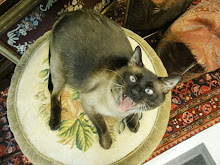
We got Joe's Preliminary Report in from Tennessee Department of Agriculture, Regulatory Services Division-Laboratory. We read it as Joe did die of Marek's Disease. Here's some of the verbiage:
Internal examination reveals that the sciatic nerves are markedly asymetrical with the left sciatic nerve being approximately three times the width of the right sciatic nerve. In addition, the spleen is diffusely enlarged to approximately two times its normal size and is reddish purple on cut section. No other abnormalities are seen at necropsy.
DIAGNOSES
Fair flesh, fair adipose deposits
Fair postmortem condition
Asymetrical sciatic nerves
Splenomegaly
Comments:
The asymatic sciatic nerves are a classic indication of Marek's Disease. Ancillary tests and limited histopathology are pending.
Marek's Disease in a nut shell... good simple explanation from:
http://www.millerhatcheries.com/Information/Diseases/marek_disease.htm
MILLER HATCHERIES
Marek's Disease in Chickens
In an economic loss, Marek's disease is a most important malady of chickens. It often causes severe death loss in pullet flocks and has been a major cause of condemnations at the broiler processing plant. Generally, chickens under 16 weeks of age are most often affected.
Cause
Caused by a herpesvirus, the disease is often characterized by abnormal cell growth in the peripheral nerves and central nervous system. Hence, the common name for one form of Marek's: fowl paralysis. In addition to the nerves, however, the disease also may cause lesions on visceral organs and other tissues, including feather follicles of the skin. The most prominent lesions may be tumors on the liver, kidneys, testes, ova, spleen and lungs. In such cases, nerve swelling may not be involved.
How Marek's Disease is Spread
Chicken "dander" from feather follicles spreads the disease. The virus also is excreted in the saliva, and the virus probably enters the body through the respiratory system. Transmission via the egg is not significant.
Signs
Some chickens die without any clinical signs of Marek's disease. Most of the affected birds will have some degree of paralysis, although chickens with the acute form may not show this condition. Those with paralysis may die because they are unable to reach feed and water. The first indication of infection is a variation in the growth rate and degree of feathering.
Lesions
Swelling of the peripheral nerves, particularly of the nerves of the leg and wing, is often noticeable. The visceral organs may contain tumors ranging from microscopic size to fairly large. Such tumor lesions may be confused with those of lymphoid leukosis without a qualified laboratory diagnosis.
Prevention
Tumor formation from Marek's disease can be prevented through vaccination. Salsbury MD-Vac, a vaccine of chick-embryo tissue culture, is recommended. Vaccination at one day of age usually protects birds through their lifetime. There is no treatment for Marek's disease.

Now it also said:
FECAL FLOTATION
Results: POSITIVE
Comments:
A few coccidial oocysts consistent with Eimeria species were observed in the sample.

I had to research what coccidial oocysts/Eimeria species were.
From internet:
What is it? Coccidiosis -- Coccidia, Coxy, or Cocci -- is a disease of poultry caused by a
protozoan-type parasite. This parasite lives and multiplies in the intestinal tract and causes tissue
damage. This damage can interfere with the food digestion and nutrient absorption, as well as
causing dehydration and blood loss. The tissue damage can also expose the bird to bacterial
infections, like Clostridium and Salmonella. Diseases that suppress the bird’s immune system
may act with coccidiosis to produce a more severe problem. For example, Marek’s Disease may
interfere with the development of coccidiosis immunity and Infectious Bursal Disease may
exacerbate a coccidia infection.
Plus I also read... it's a good write up...
http://www.clemson.edu/public/lph/ahp/disease_links/images/coccidia.pdf
Let's talk chicken poop! I never saw signs of that. The girls and Joe's poop ALWAYS looked healthy. Up until the day Joe died, his poop was the only thing that looked good on that little rooster. I never saw blood or any abnormalities. I ALWAYS keep an eye out for that. It a good way to see signs if your birds are sick.
Here's a great link with pictures of healthy chicken poop and sick chickens poop... it's actually interesting...
http://www.chat.allotment.org.uk/index.php?topic=17568.0
The girls seem fine other then they are molting, feathers are everywhere! The new feathers are coming in and thick on them. Bumblefoot is healing, we check that every other day. We're still fighting the body lice. The girls have no sign of live adult lice but have lice eggs attached to the base of their feathers below their vents and on their neck. Their poop looks in the normal range, still eating and they are ripping up the tomato plants in the beds... seems good to me. They are ALWAYS curious of what I have in my hands... that how I get them to come to me so I can catch them to look at them. They still haven't figured that out yet.
By the time Brian and I study all the information on diseases and parasites, I think we're going to specialize in chicken/rooster health! We are definitely learning!




















No comments:
Post a Comment